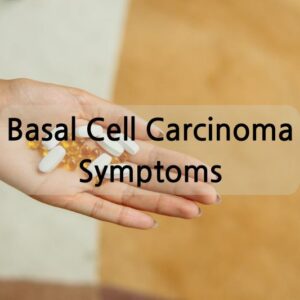Basal Cell Carcinoma (BCC) is the most common type of skin cancer, typically originating in the basal cells of the skin’s outer layer. Understanding its symptoms is crucial for early detection and effective treatment.

Causes and Risk Factors
Excessive exposure to ultraviolet (UV) radiation from sunlight is the primary cause of BCC. Other risk factors include genetic predisposition, advanced age, and a weakened immune system.
Types of Basal Cell Carcinoma
BCC manifests in various forms, including superficial, nodular, and infiltrative types, each with distinct characteristics and growth patterns.
Common Symptoms
- Persistent Bumps or Patches: BCC often appears as a raised, translucent bump or a reddish patch on the skin that persists over time.
- Waxy or Shiny Appearance: Affected areas may exhibit a shiny or waxy texture, resembling a scar.
- Bleeding or Scabbing: BCC lesions can intermittently bleed or develop a crusty scab, especially after minor trauma.
- Changes in Existing Moles: Existing moles may change in size, shape, or color, indicating potential malignancy.
Less Common Symptoms
- Ulceration: In advanced cases, BCC lesions may ulcerate, forming non-healing sores on the skin.
- Pigmented Basal Cell Carcinoma: Some BCCs may contain pigmentation, resembling melanoma, making diagnosis challenging.
- Neural Symptoms: Rarely, BCC can affect nerves, causing pain, tingling, or numbness in the affected area.
Diagnosis and Detection
BCC diagnosis involves a thorough physical examination by a dermatologist, often followed by a biopsy to confirm the presence of cancerous cells. Imaging tests such as ultrasound or MRI may be recommended for assessing tumor depth and extent.
Treatment Options
Treatment for BCC varies depending on the size, location, and subtype of the lesion. Common approaches include surgical excision, Mohs micrographic surgery, cryotherapy, radiation therapy, and topical medications like imiquimod or 5-fluorouracil.
Prevention Strategies
Preventing BCC involves minimizing UV exposure through sunscreen use, protective clothing, and seeking shade during peak sunlight hours. Regular skin examinations and avoidance of tanning beds are also crucial for early detection and prevention.
Living with Basal Cell Carcinoma
A diagnosis of BCC can evoke various emotions, including fear, anxiety, and uncertainty. Building a strong support network and seeking professional counseling can help individuals cope with the emotional impact of the disease.
Outlook and Prognosis
With early detection and appropriate treatment, the prognosis for BCC is generally excellent, with high cure rates. However, regular follow-up visits are necessary to monitor for recurrence and new lesions.
Conclusion
Understanding the symptoms of basal cell carcinoma is essential for timely diagnosis and effective management. By recognizing the signs and seeking prompt medical attention, individuals can improve their chances of successful treatment and long-term survival.
FAQs
What are the main symptoms of basal cell carcinoma?
The main symptoms include persistent bumps or patches, waxy or shiny appearance, bleeding or scabbing, and changes in existing moles.
Can basal cell carcinoma go away on its own?
No, BCC does not typically resolve spontaneously and requires medical intervention for treatment.
Is basal cell carcinoma fatal?
While BCC rarely metastasizes, untreated or neglected cases can lead to disfigurement or, in rare instances, life-threatening complications.
How often should I check my skin for signs of basal cell carcinoma?
Regular self-examinations of the skin are recommended, ideally on a monthly basis, to monitor for any new or changing lesions.
Can I prevent basal cell carcinoma by avoiding sunlight exposure?
Minimizing UV exposure through sun protection measures can significantly reduce the risk of developing BCC, but genetic factors and other risk factors also play a role.
Learn more about basal cell cancer!
